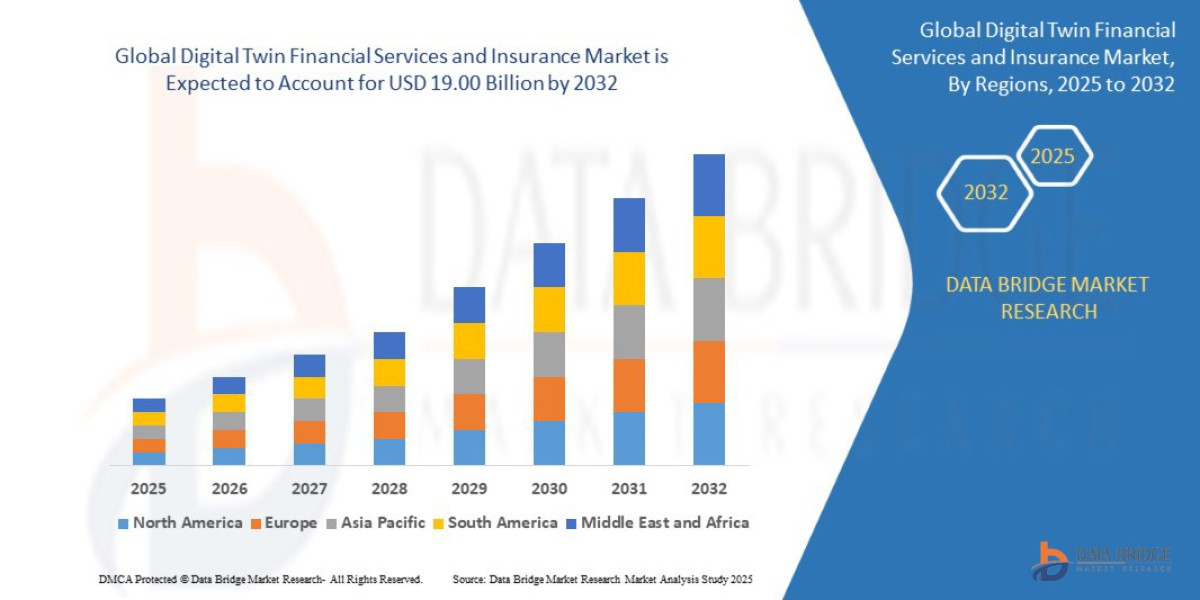"Executive Summary Digital Twin Financial Services and Insurance Market Market Size and Share: Global Industry Snapshot
- The global digital twin financial services and insurance market size was valued at USD 5.67 billion in 2024 and is expected to reach USD 19.00 billion by 2032, at a CAGR of 16.30% during the forecast period
For an actionable market insight and lucrative business strategies, a faultless market research report has to be there. The credible Digital Twin Financial Services and Insurance Market Market report covers all the studies and estimations that are involved in the method of standard market research analysis. This market report endows with a profound overview of product specification, technology, product type and production analysis by considering most important factors such as revenue, cost, and gross margin. Digital Twin Financial Services and Insurance Market Market report is a window to the Digital Twin Financial Services and Insurance Market Market industry which defines properly what market definition, classifications, applications, engagements and market trends are.
An all-inclusive Digital Twin Financial Services and Insurance Market Market research report comprises of different industry verticals such as company profile, contact details of manufacturer, product specifications, geographical scope, production value, market structures, recent developments, revenue analysis, market shares and possible sales volume of the company. The market insights acquired through this market research report facilitates more defined understanding of the market landscape, issues that may interrupt in the future, and ways to position specific brand brilliantly. A market overview is given in terms of drivers, restraints, opportunities and challenges where each of this parameter is studied scrupulously. Digital Twin Financial Services and Insurance Market Market report works as a superb guide for actionable ideas, enhanced decision-making and better business strategies.
Stay informed with our latest Digital Twin Financial Services and Insurance Market Market research covering strategies, innovations, and forecasts. Download full report: https://www.databridgemarketresearch.com/reports/global-digital-twin-financial-services-and-insurance-market
Digital Twin Financial Services and Insurance Market Market Trends & Analysis
Segments
- By Technology: The digital twin financial services and insurance market can be segmented based on technology into predictive maintenance, product design and development, and performance monitoring. Predictive maintenance uses digital twin technology to anticipate maintenance needs and prevent potential issues before they occur. Product design and development segment applies digital twin models to create and optimize new financial products or insurance offerings. Performance monitoring involves using digital twins to track and analyze the performance of financial services and insurance processes in real time.
- By Application: This market segment includes risk management, customer service optimization, fraud detection, and compliance monitoring. Risk management involves using digital twin technology to assess and mitigate risks in financial services and insurance operations. Customer service optimization focuses on improving customer experiences by creating personalized services through digital twin models. Fraud detection segment utilizes digital twins to identify anomalies and potential fraud within financial transactions. Compliance monitoring ensures that financial institutions adhere to regulatory requirements by using digital twin technology to track and manage compliance processes.
- By End-User: The digital twin financial services and insurance market can also be categorized based on end-user segments such as banks, insurance companies, and investment firms. Banks utilize digital twin technology to enhance operational efficiency, improve risk management, and personalize customer experiences. Insurance companies adopt digital twins for underwriting, claims processing, and fraud detection. Investment firms leverage digital twins to optimize investment strategies, risk assessment, and portfolio management.
Market Players
- IBM Corporation: IBM offers digital twin solutions for financial services and insurance industries, enabling organizations to streamline operations, enhance customer experiences, and mitigate risks through predictive analytics and AI capabilities.
- Siemens AG: Siemens provides digital twin technology for financial services and insurance sectors, allowing companies to create virtual models of assets, processes, and systems to improve decision-making, optimize performance, and drive innovation.
- Microsoft Corporation: Microsoft offers digital twin platforms for financial institutions and insurance companies, enabling them to create digital replicas of physical and virtual assets to drive operational efficiencies, enhance customer engagement, and accelerate digital transformation.
- General Electric Company: General Electric specializes in digital twin solutions for the financial services and insurance sector, helping organizations monitor asset performance, analyze data in real time, and make informed decisions to optimize business processes and drive growth.
The global digital twin financial services and insurance market is witnessing significant growth due to the increasing adoption of digital twin technology by financial institutions and insurance companies to improve operational efficiency, enhance customer experiences, and mitigate risks. The market players mentioned above are actively involved in developing and offering advanced digital twin solutions tailored to the specific needs of the financial services and insurance industry, driving innovation and transformation in the sector. The emergence of technologies such as AI, IoT, and predictive analytics is further fueling market growth by enabling organizations to create more sophisticated digital twin models for a wide range of applications. With the rising demand for data-driven insights, real-time monitoring, and predictive capabilities, the digital twin financial services and insurance market is poised for continued expansion in the coming years.
The digital twin technology in the financial services and insurance market is revolutionizing the way organizations operate, innovate, and manage risks. One key trend shaping the market is the increasing focus on personalized customer experiences. Financial institutions and insurance companies are leveraging digital twin models to tailor their services and products to individual preferences and needs, enhancing customer satisfaction and loyalty. This trend is driven by the growing demand for customized solutions in a highly competitive market landscape, where differentiation through personalized offerings can be a key driver of success.
Another significant trend in the digital twin financial services and insurance market is the emphasis on real-time monitoring and analysis. Companies are utilizing digital twin technology to gain instant insights into their operations, identify potential issues or opportunities, and make data-driven decisions on the go. Real-time monitoring enables organizations to enhance efficiency, react promptly to changing market conditions, and optimize performance across various processes such as risk management, fraud detection, and compliance monitoring.
Moreover, the integration of emerging technologies such as artificial intelligence (AI) and Internet of Things (IoT) is reshaping the digital twin landscape in the financial services and insurance sectors. AI-powered algorithms are being used to enhance predictive capabilities, automate decision-making processes, and unlock valuable patterns and trends from vast amounts of data. By combining digital twins with IoT devices, organizations can create interconnected systems that enable seamless data exchange, remote monitoring, and optimization of asset performance.
Furthermore, regulatory compliance is a key driver influencing the adoption of digital twin technology in the financial services and insurance market. With increasingly stringent regulations governing data privacy, security, and transparency, organizations are turning to digital twins to streamline compliance processes, ensure data integrity, and demonstrate adherence to regulatory requirements. By leveraging digital twins for compliance monitoring and reporting, companies can reduce the risks of non-compliance, mitigate potential penalties, and build trust with regulators and customers.
In conclusion, the digital twin financial services and insurance market is experiencing rapid evolution driven by trends such as personalized customer experiences, real-time monitoring, integration of AI and IoT, and regulatory compliance. Companies that embrace digital twin technology stand to gain a competitive edge by improving operational efficiencies, enhancing customer engagement, and staying ahead of industry disruptions. As market players continue to innovate and develop advanced solutions tailored to industry-specific needs, the digital twin financial services and insurance market is poised for sustained growth and transformation in the foreseeable future.One key aspect to consider in the digital twin financial services and insurance market is the increasing emphasis on enhancing cybersecurity measures. As financial institutions and insurance companies integrate digital twin technology into their operations, the need to safeguard sensitive data and critical systems becomes paramount. Cyber threats continue to evolve in sophistication and scale, posing significant risks to organizations utilizing digital twins for various applications. In response, market players are investing in robust cybersecurity solutions and protocols to protect digital twin models, networks, and information assets from cyber attacks, data breaches, and other security vulnerabilities. Strengthening cybersecurity frameworks and implementing proactive measures to detect and mitigate threats are crucial for ensuring the integrity and resilience of digital twin ecosystems within the financial services and insurance sector.
Additionally, the convergence of digital twin technology with blockchain solutions is emerging as a disruptive trend shaping the market landscape. Blockchain, known for its decentralized and transparent nature, offers secure, tamper-resistant data storage and transaction capabilities that complement the concept of digital twins in financial services and insurance. By leveraging blockchain technology in conjunction with digital twins, organizations can enhance data integrity, traceability, and auditability across complex processes such as claims processing, asset management, and regulatory reporting. The immutable nature of blockchain ensures that digital twin models remain authentic and immutable, fostering trust among stakeholders and enabling seamless collaboration in a secure environment. The integration of blockchain with digital twin technology opens up new opportunities for innovation, efficiency, and trust in the digital transformation journey of financial services and insurance providers.
Moreover, the increasing focus on sustainability and environmental impact is driving organizations in the financial services and insurance sector to leverage digital twin technology for sustainability initiatives and green practices. By creating virtual replicas of physical assets, buildings, and infrastructure, companies can simulate and optimize energy consumption, resource utilization, and operational efficiency to minimize environmental footprint and support sustainable business practices. Digital twins enable organizations to analyze environmental data, identify opportunities for energy savings and carbon footprint reduction, and implement proactive measures to achieve sustainability goals while maintaining operational effectiveness. Integrating environmental considerations into digital twin models empowers organizations to make informed decisions, optimize resource management, and demonstrate corporate social responsibility in alignment with global sustainability agendas.
In conclusion, the evolving trends of cybersecurity enhancement, blockchain integration, and sustainability focus are reshaping the digital twin landscape in the financial services and insurance market, offering new avenues for innovation, risk mitigation, and sustainable growth. By addressing cybersecurity challenges, exploring blockchain opportunities, and embracing sustainability practices through digital twin technology, organizations can unlock value, resilience, and competitive advantage in an increasingly digital and interconnected business environment. As market players continue to adapt to these trends and harness the potential of digital twins for strategic decision-making and operational excellence, the future outlook for the digital twin financial services and insurance market is characterized by resilience, sustainability, and transformative potential.
Learn about the company’s position within the industry
https://www.databridgemarketresearch.com/reports/global-digital-twin-financial-services-and-insurance-market/companies
Digital Twin Financial Services and Insurance Market Market Overview: Strategic Questions for Analysis
- Which technologies are enhancing customer experience?
- How do climate conditions affect product demand?
- What is the return rate of products in the Digital Twin Financial Services and Insurance Market Market?
- How are companies building brand awareness?
- What role do trade shows play in this Digital Twin Financial Services and Insurance Market Market?
- How has the B2B segment evolved?
- What partnerships exist with logistics providers?
- Which region has the highest customer lifetime value?
- How do brands manage customer feedback?
- What are the top loyalty-building tactics?
- What marketing channels have the highest ROI?
- How is CSR (Corporate Social Responsibility) leveraged?
- What’s the conversion rate in digital campaigns?
- How are enterprises managing inventory?
Browse More Reports:
Global Hair and Care Market
Global Kitchen Knives Market
Global Small Domestic Appliances (SDA) Market
Global Baby Apparel Market
Global Hangers Market
Global Next Generation Sequencing Data Analysis Market
Global Omega 3 Market
Global Laundry Detergent Market
Global Pet Companion Robots Market
Southeast Asia Aesthetic Services Market
Global Augmented Reality (AR) and Mixed Reality (MR) Market
Global Alpaca Fiber Market
Global Polyethylene Terephthalate (PET) Market
Global Wood Pellet Market
Global Ready to Eat Food Market
About Data Bridge Market Research:
An absolute way to forecast what the future holds is to comprehend the trend today!
Data Bridge Market Research set forth itself as an unconventional and neoteric market research and consulting firm with an unparalleled level of resilience and integrated approaches. We are determined to unearth the best market opportunities and foster efficient information for your business to thrive in the market. Data Bridge endeavors to provide appropriate solutions to the complex business challenges and initiates an effortless decision-making process. Data Bridge is an aftermath of sheer wisdom and experience which was formulated and framed in the year 2015 in Pune.
Contact Us:
Data Bridge Market Research
US: +1 614 591 3140
UK: +44 845 154 9652
APAC : +653 1251 975
Email:- corporatesales@databridgemarketresearch.com
"





